Sustainable Seas Through the Eyes of Art
Introduction
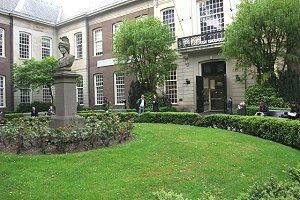 The International Initiative 'Science, Arts and Sustainable Seas' was offered the opportunity for an exhibition 'Sustainable Seas Through the Eyes of Art' associated with the V MARE Conference 'Living with uncertainty and adapting to change' in Amsterdam, 9-11 July 2009. The venue of the exhibition is the historic university building, Oudemanhuispoort 4-6, 1012 DL Amsterdam.
The International Initiative 'Science, Arts and Sustainable Seas' was offered the opportunity for an exhibition 'Sustainable Seas Through the Eyes of Art' associated with the V MARE Conference 'Living with uncertainty and adapting to change' in Amsterdam, 9-11 July 2009. The venue of the exhibition is the historic university building, Oudemanhuispoort 4-6, 1012 DL Amsterdam.
The development phase of the exhibition engaged scientists, artists and schools in Brazil, Belgium, Germany, Guinea, Morocco, Nigeria, Peru and Senegal and fishing communities in Senegal and Nigeria. The exhibition at the MARE Conference will bring together a selection of works. It marks an important stepping stone in the early development of the Initiative and its engagement with a wider public.
For more information on the MARE Conference, click here.
The Conference is preceded by a Policy Day on 8 July 2009 under the motto "Dealing with sea-level rise in deltaic regions: an international comparison". The venue is the Waalse Kerk and the Bushuis, University of Amsterdam. For the programme, click here.
Two international scientific collaborations have produced interesting results and tools for public use, which have inspired the exhibition. Some researchers associated with these projects provided some coaching and scientific advice. For more information on these two projects click here ECOST and INCOFISH.
Ségolène Jeanjean prepared a powerpoint presentation to explain some of the issues that motivate the exhibition.
The students at the European School Brussels I have launched a fund raising appeal to allow Senegalese and other West African youth and their coaches to come to Amsterdam themselves, meet and make friends with the European students. Even after the exhibition, you can support the activities with donations to the account to continue and expand the collaboration. Thank you!

The youth groups and coaches contributing to the exhibition, supporting scientists and artists let you take a glimpse at preparatory steps and how the collaboration is developing.
Preparations in Hilden, Arts Working Group of the Helmholtz-Gymnasium Hilden, Germany
Since the foundation of the Arts Working Group of the Helmholtz – Gymnasium Hilden (HGH) in the summer of 2007, we, 18 committed young people between 15 and 20 years old, confront our surroundings regularly through the eyes of the arts. In the context, we set up a big exhibition last year (2008) in a public exhibition space of our home town.
We see our participation in exhibition project „Sustainable Seas Through the Eyes of Art“ as an opportunity to position ourselves in relation to political issues and to act more consciously as Europeans and citizens who are co-responsible for global problems.
 Following an invitation of Dr. Cornelia Nauen to visit Brussels, we had the opportunity to acquaint ourselves with the regional representation of our Land NRW in Brussels, the European Commission, the European Parliament and the European School in Brussels. This way we learnt more about the precursor of this project as well as its scientific and political background.
Following an invitation of Dr. Cornelia Nauen to visit Brussels, we had the opportunity to acquaint ourselves with the regional representation of our Land NRW in Brussels, the European Commission, the European Parliament and the European School in Brussels. This way we learnt more about the precursor of this project as well as its scientific and political background.
Back in Hilden we teamed up with a local cooperation partner, the Aquazoo Düsseldorf, whose scientific staff introduced us to more in-depth knowledge about the reef ecosystems and their increasing destruction through dynamite and cyanide fishing, bottom trawling and unsustainable tourism. Global warming as a result of climate change is another major threat to corals. Together with other stress factors it results in bleaching (loss of colour of the corals as a result of expulsion of symbiotic unicellular algae) and ultimately coral death.
 Since August 2008 we are already working on canvasses, three-dimensional objects, photography and collages all around the maritime theme. We are trying to capture the positive as well as the critical aspects.
Since August 2008 we are already working on canvasses, three-dimensional objects, photography and collages all around the maritime theme. We are trying to capture the positive as well as the critical aspects.
We expect the exhibition project „Sustainable Seas Through the Eyes of Art“ to open up successful national and internationanl cooperation and an enrichment of our human and artistic development.
Our coach is Mr Ansgar Sebastian Beer, teacher for art and biology at the HGH and registered artist in Düsseldorf.
Click here for the general website of our school.
Preparations in Brussels, Belgium
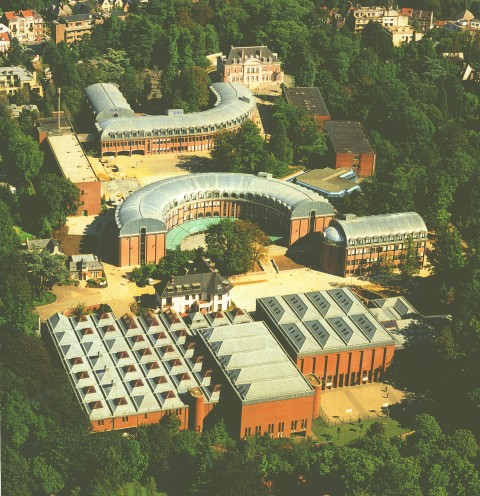
We are a group of students (17 to 19 years old) preparing for bacalaureat at the European School Brussels I, Belgium. We are mostly children of officials in the European Institutions with family backgrounds mostly from different parts of Europe. There are currently about 3,200 students in all sections from kindergarten to secondary. We are lucky to have a beautiful school.
In the Arts class (4h/week) of Ms. Ghallale we engaged during last school year (2008) in a twinning with the College in Kayar, a fishing village north of Dakar, the capital of Senegal. This started out with a concern of massive environmental degradation of the sea and the coast. In Senegal the fish catches of the small-scale fishermen operating out of Kayar are only a fraction of what they were only a few years ago and the loss of productivity from massive overfishing mostly by industrial vessels (many from abroad or foreign vessels 'going local') threatens the livelihood of the entire community, even though they also produce vegetables for Dakar and engage in some trade.
We wanted to articulate our reaction to the scientific facts of overfishing and other problems through works of art that would instill a sense of shock and alert in the visitors. We wanted to make them aware that we can not take healthy oceans and ecosystems for granted, just like we were initially not aware of the problems, because we were not confronted first hand with them earlier on.
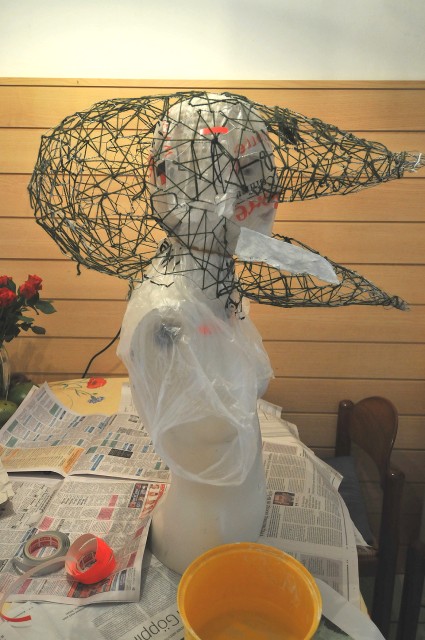
It was in this context that we organised our first exhibition in the occasion of the 50th anniversary of the European School Brussels I, 23-24 May 2008. Under the auspices of the European Research Commissioner, Dr. Janez Potočnik, we displayed 57 pieces from the students in Kayar and from our own production. In the faces and the comments of the visitors, we saw much more emotional reactions than one normally stimulates with a scientific publication. See the pictures of this exhibition here.
Have a look at some impressions from our 50th anniversary celebrations with many cultural and culinary attractions (see the article in the student newsletter 'Connection' in French).
The success and the positive reactions to the exhibition triggered the wish to continue and expand by opening to other school groups, scientists, artists and anybody interested in more sustainable seas and societies. This is when, thanks to some of the initial promoters, contacts were established to people elsewhere: Brazil, Germany, Guinea, Italy, Morocco, Netherlands, Nigeria, Peru.
The current phase of preparations in Brussels
We were also looking for an opportunity to bring ideas and work going on in the different locations together in another joint exhibition. This is why were were very happy about the invitation to contribute to another, somewhat bigger, exhibition in Amsterdam, in the premises of the V MARE Conference, 9-11 July 2009.
And foremost, we know much more needs to be done, because the problems of overfishing and other utterly unsustainable practices are not going away at all. This is why Ségolène Jeanjean put together a slide show for more awareness on rampant overfishing. At the same time, we believe that collaborating with other youth groups in other European and African countries and elsewhere will allow us to gain valuable new experiences and open new horizons, especially as we are about to leave school and enter a new phase of our lives.
And this time round, we want to meet face-to-face with the African and European participants, not only show their work! This is why we are, among others, fund raising for the participation of African groups in Amsterdam as seen in the opening menu.
Watch out for more news as the Amsterdam exhibition dates come closer.
Coordinator: Giulia BOTTONI (IT/DE)
Coach: Ms. Bettina GHALLALE, Arts Coordinator at the European School Brussels I
Click here for the general website of our school.
Preparations in Kayar and Dakar, Senegal
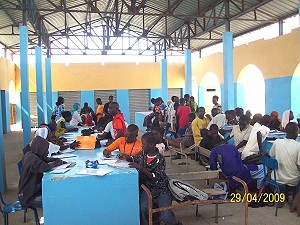 The Principal of the College (CEM) in Kayar, Mr. Abibou Diop, with the support of Aliou Sall, researcher in the ECOST Project and Head of the local NGO CREDITIP, has pursued efforts to develop relations with European schools and strengthening of art work in his school around the issues of sustainable seas and general education.
The Principal of the College (CEM) in Kayar, Mr. Abibou Diop, with the support of Aliou Sall, researcher in the ECOST Project and Head of the local NGO CREDITIP, has pursued efforts to develop relations with European schools and strengthening of art work in his school around the issues of sustainable seas and general education.
Dr. Sall, with his many connections to traditional fishing communities in Senegal, has also obtained collaboration from the artist and photographer in Saint Louis, Alboury Ndiaye as well as continued support of Dakar-based artist and sculptor, Samba Laye Diop.
As far as the specific stages of preparations in Kayar are concerned, it is useful to know about the methodology adopted before getting to the actual realisation of art works. Infact, the preparations went through the following process:
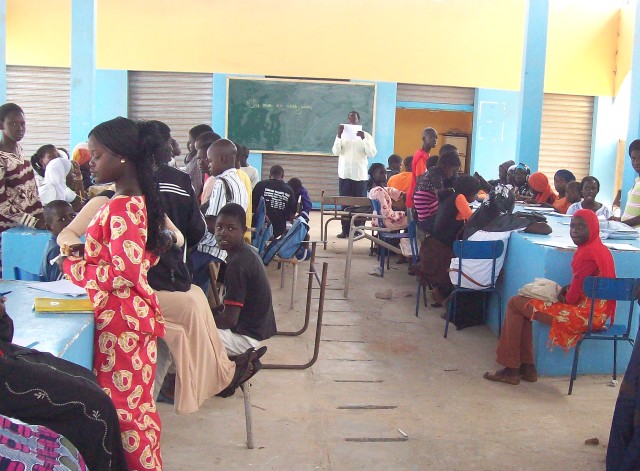
1. At the onset, there was a first meeting, in April 2009, in the premises of the Departmental Fisheries Service, that is the public institution representing the Ministry of Maritime Economy and International Maritime Transport, Marine Fisheries Directorate, at the level of the Thiès Region, in which the town of Kayar is located. The twin objectives of the meeting were:
a) To establish a synergy with the administrative services representing the central authorities (the Senegalese State) at local level in Kayar by getting them interested in the project by way of simple incentives to become active in the undertaking not only for Amsterdam, but also in a longer-term perspective;
b) To allow the teachers and students of the school in Kayar to better familiarise themselves with the concept of 'sustainable development' and its translation into practice. For this reason, the following persons with a confirmed expertise in fisheries have been invited to intervene:
 Dr Issa MBENGUE: Fisheries Service Chief of the Thiès Region,
Dr Issa MBENGUE: Fisheries Service Chief of the Thiès Region,- Colonel Abdoulaye DIOP: Park ranger of the Marine Protected Area in Kayar,
- Two teachers of life sciences and science of the earth of the CEM Kayar, namely Ms. Fatoumata SOUMARE and Mr. Mamadou DIOUF.
 2. The second stage consisted of imparting more arts lessons to the students of the CEM Kayar in the large hall near the beach, which normally serves to handle freshly landed fish. This hall had been occupied by the CEM Kayar out of lack of suitable own rooms at the school itself. The best performers have been invited to a course in May in the arts village in Dakar.
2. The second stage consisted of imparting more arts lessons to the students of the CEM Kayar in the large hall near the beach, which normally serves to handle freshly landed fish. This hall had been occupied by the CEM Kayar out of lack of suitable own rooms at the school itself. The best performers have been invited to a course in May in the arts village in Dakar.
3. The third phase involved to go to the artist Abdoulaye Seck for the actual realisation of new paintings. The session called artistic creation was preceded for methodological reasons by a series of questions and answers animated by the artist himself. This session helped the pupils to articulate their 'project of expression'. It is after this initial exercise that the students implemented their projects along the lines of the following themes:
-
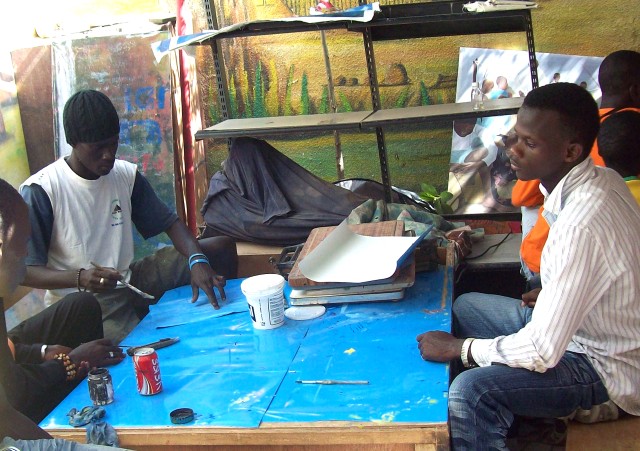 The monofilament gillnet against which the village of Kayar fights since several years given its negative effects on the marine environment of this fishing method,
The monofilament gillnet against which the village of Kayar fights since several years given its negative effects on the marine environment of this fishing method, -
The clandestine emigration on pirogues which, in the last years provoked hundreds of fatalities (of young people) among those wanting to reach the Canary Islands from Kayar and other beaches by boat,
-
The pollution and decline of marine and coastal resources due to the combined effects of natural climate effects and human intervention,
-
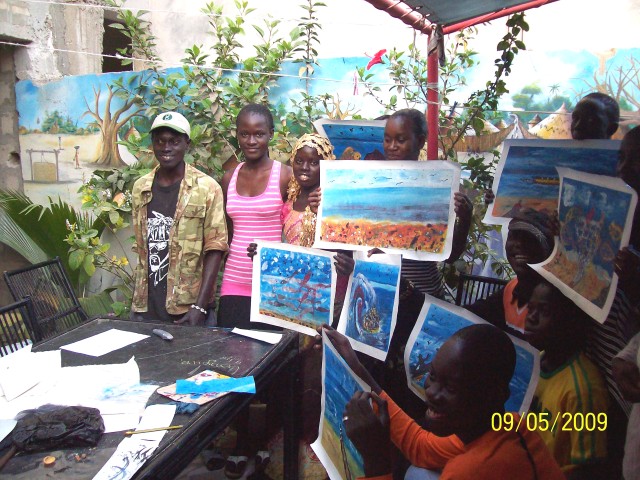 The swell and its crossing, which is a point of honour for the fishermen who have to demonstrate day after day their courage and skill associated with the maritime occupations of the Kayar fishermen,
The swell and its crossing, which is a point of honour for the fishermen who have to demonstrate day after day their courage and skill associated with the maritime occupations of the Kayar fishermen, -
The vistas of the village showing the panorama of Kayar and the beauty of the place of which the youngsters are proud.
 This foremost fishing town in Senegal is at a turning point, because the decline of resources, mostly as a result of overfishing, in combination with demographic and other pressures is threatening its future.
This foremost fishing town in Senegal is at a turning point, because the decline of resources, mostly as a result of overfishing, in combination with demographic and other pressures is threatening its future.
The WWF webpage on Kayar summarises some of the issues. It is in this context that the young people grow up and produce the works on display in the exhibition (see also the link to the documentary - 'Cry Sea' in the Kayar Section).
Preparations in Port Harcourt, Nigeria
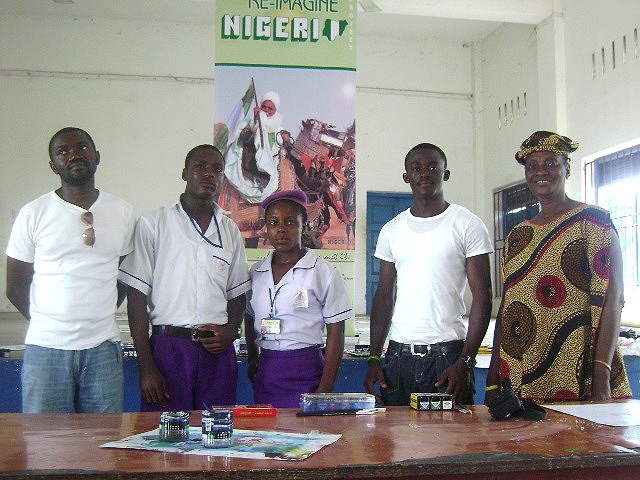 Prof. Stella Williams is teaching agricultural economics at the Obafemi Awolowo University in Ile Ife and has spent many years researching artisanal fisheries in Nigeria's Delta Region and elsewhere.
Prof. Stella Williams is teaching agricultural economics at the Obafemi Awolowo University in Ile Ife and has spent many years researching artisanal fisheries in Nigeria's Delta Region and elsewhere.
Now close to retirement, she is also an activist against environmental degradation and social exclusion which spawns much of the violence in the Delta.
Some of her former students live in the Delta region and experience the hardship of a depressed economic situation, violence and lack of perspective which are particularly hard to take for young people.
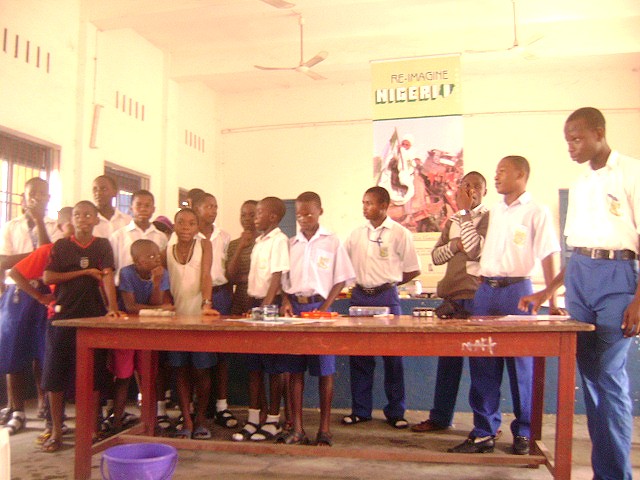 Nduwhite Ndubuisi Ahanonu, from Oguta in Imo State, is a graduate of Fine and Applied Arts (University of Nigeria Nsukka 2000).
Nduwhite Ndubuisi Ahanonu, from Oguta in Imo State, is a graduate of Fine and Applied Arts (University of Nigeria Nsukka 2000).
He has participated already in several exhibitions and is at present a studio artist, an Art Consultant and a Cultural activist.
He is the National Coordinator for the "Magnificent 10 Fingers Artist Society' (MAFAS10). He was the only African selected for Midbar International Artists Residency Israel 2006.
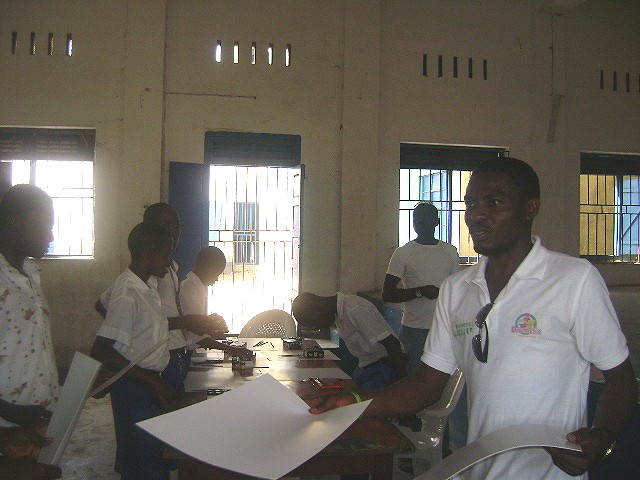 The meeting of our two minds brought together our different perspectives on how to use the sciences and the arts to look for alternatives together with young people from the Delta Region in Port Harcourt.
The meeting of our two minds brought together our different perspectives on how to use the sciences and the arts to look for alternatives together with young people from the Delta Region in Port Harcourt.
When we heard about the plans for the exhibition in Amsterdam and the possibility to work with scientists, artists, school teachers and young people from elsewhere, we saw this as an opening on the stony road to improvements on the ground.
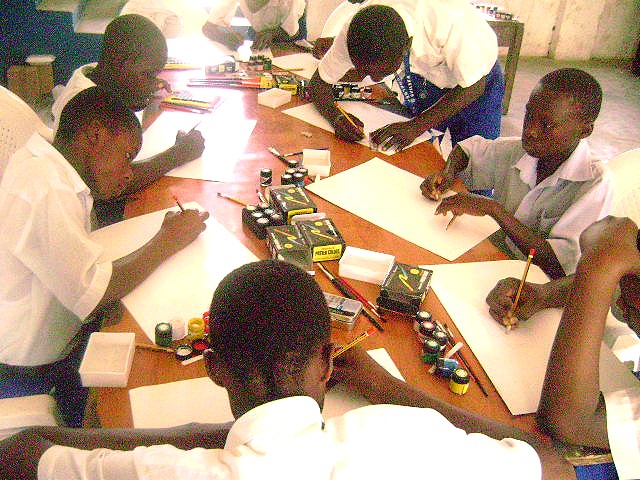 Here are some impressions on the initial steps of the group work with students of peace clubs of three schools, the Stella Maris College in Port Harcourt, the Community Secondary School Ochokiri, Okrika and the Community Secondary School Abuloma, all in Rivers State, Nigeria.
Here are some impressions on the initial steps of the group work with students of peace clubs of three schools, the Stella Maris College in Port Harcourt, the Community Secondary School Ochokiri, Okrika and the Community Secondary School Abuloma, all in Rivers State, Nigeria.
 Peace Club Coordinator, Mr. Atu Baridapdoo and Vice Principal Academics, Mr. Ibims Samuel, of Stella Maris College were also actively involved, as was the Peace Club Coordinator of Community Secondary School Okochiri, Okrika, Mr. Basil Paul A.
Peace Club Coordinator, Mr. Atu Baridapdoo and Vice Principal Academics, Mr. Ibims Samuel, of Stella Maris College were also actively involved, as was the Peace Club Coordinator of Community Secondary School Okochiri, Okrika, Mr. Basil Paul A.
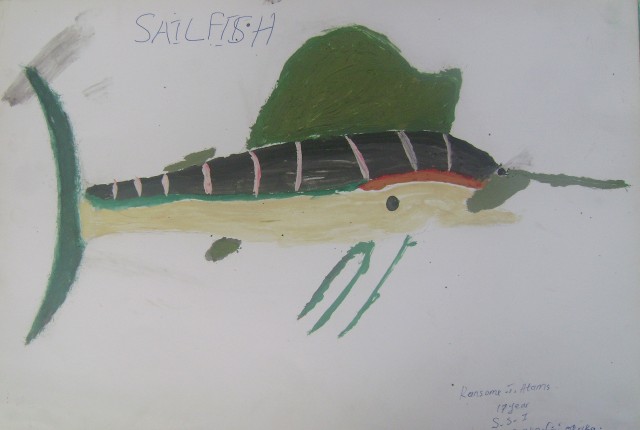
Preparations in Safi, Morocco
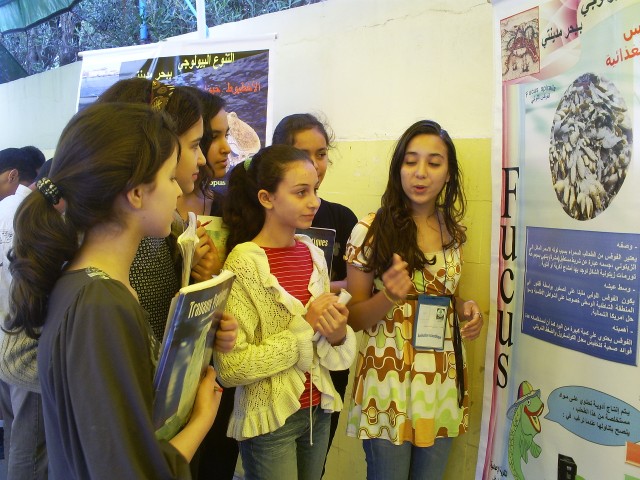 Our school, l'Ecole du Plateau Bensouda in Safi, has a tradition of combining high standards of academic education with introductions to artistic expression in the form of theatre, painting, dance, pottery and other forms.
Our school, l'Ecole du Plateau Bensouda in Safi, has a tradition of combining high standards of academic education with introductions to artistic expression in the form of theatre, painting, dance, pottery and other forms.
We are a mixed education establishment (open to girls and boys) and cover maternity, primary and secondary school sections. Safi is a coastal town on the Atlantic coast of Morocco.
Following the initiative of the Safi Teachers' Association S.V.T. six months of activities have been carried out in several schools on the theme: 'Marine Biodiversity of our City'. The objective was to introduce the students to biodiversity in nature, the importance of the sea for our lives, the wealth of our natural heritage and the importance of keeping it intact.
With the professional coaching of several teachers and including 8 students of our school, we entertained a rich programme of activities culminating in an exhibition in our school on 17 May 2009. It summarised the research findings and the results of our own explorations.
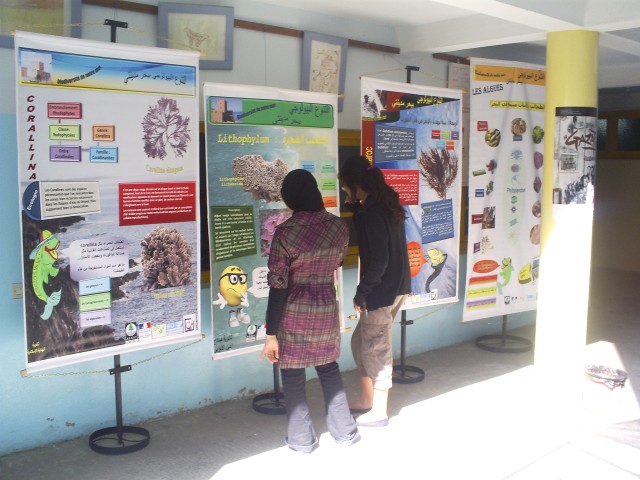 See the pictures of the exhibition and some of the students and teachers involved. The French summary account by A. El Mekkaoui, Teacher at the Lycée Plateau Bensouda, is available here.
See the pictures of the exhibition and some of the students and teachers involved. The French summary account by A. El Mekkaoui, Teacher at the Lycée Plateau Bensouda, is available here.
We are also preparing a big school party for 27 June 2009 under the motto 'The Sea – this big unknown, but vulnerable entity' ('La mer – cette grande inconnue vulnérable').
We have already sent some paintings to the exhibition in Amsterdam, even if nobody can participate in person this time. But perhaps we can invite you to another joint event to Morocco? You are most welcome here.
For those who have not been to Safi before, here are some information to give you already an idea. Safi was a port the Phenicians use already for their navigation along the African coast. The famous North African historian, mathematician, astronomer, lawyer and statesman, Ibn Khaldoun (1332-1406), called Safi “the city of the ocean”.
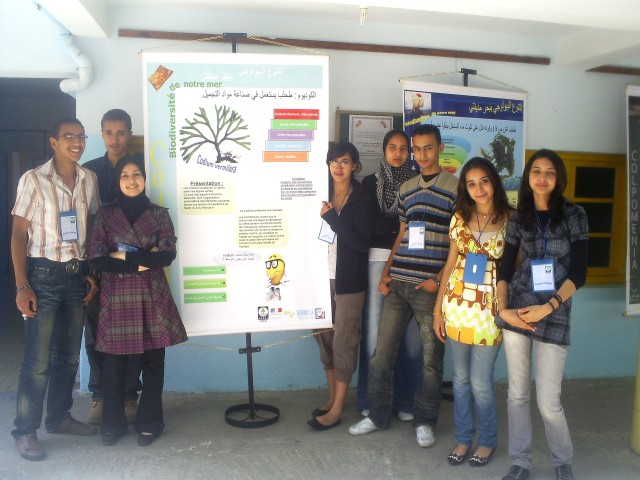 More recently, it became the “sardine capital” because of the important industrial fleet and processing capacity. The 120 km of coast worked from Safi nowadays supports a fleet of 64 sardine vessels, 83 bottom trawlers, 217 longliners and 955 small fishing boats giving employment to 32,000 fishermen (22% of the Moroccan total). The 25 shipyards in Safi put out 60 new units per year and repair or overhaul 300.
More recently, it became the “sardine capital” because of the important industrial fleet and processing capacity. The 120 km of coast worked from Safi nowadays supports a fleet of 64 sardine vessels, 83 bottom trawlers, 217 longliners and 955 small fishing boats giving employment to 32,000 fishermen (22% of the Moroccan total). The 25 shipyards in Safi put out 60 new units per year and repair or overhaul 300.
The fleet lands some 7,000 tonnes of fish and seafood per year for an estimated value of 46 million dirham. 70% of the landed quantities are for the canneries. The principal fishing season used to be from March to October, but overfishing and environmental change and degradation have led to diminishing catches in recent years.
The principal species vary according to the fleets and their fishing methods. The demersal (bottom) fleet is operated by bottom trawlers and the small fishing boats and represents the highest value fishing activity.
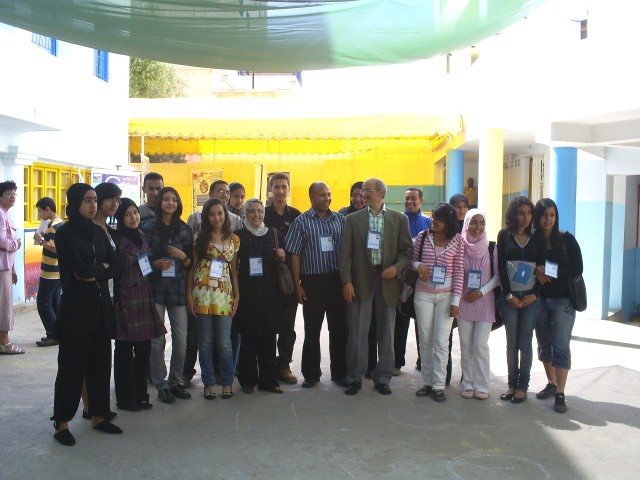 The principal species landed are squid, conger, shrimps, gambas, gurnard, lobster, hake, seabass, spiny lobster, red pandora, (slender) rockfish, striped red mullet, sole, seabream and turbot. The industrial fishery targets principally the open water (pelagic) species, mostly sardines, mackerel, tuna and anchovy. If you want to learn more about these fishes, look them up in FishBase (www.fishbase.org), for other marine life, look at www.sealifebase.org.
The principal species landed are squid, conger, shrimps, gambas, gurnard, lobster, hake, seabass, spiny lobster, red pandora, (slender) rockfish, striped red mullet, sole, seabream and turbot. The industrial fishery targets principally the open water (pelagic) species, mostly sardines, mackerel, tuna and anchovy. If you want to learn more about these fishes, look them up in FishBase (www.fishbase.org), for other marine life, look at www.sealifebase.org.
The student newsletter "Echos Plateau" no. 13 focused thematically on the sea. It is published in French and Arabic and recently won a prize for best francophone student newsletter.









